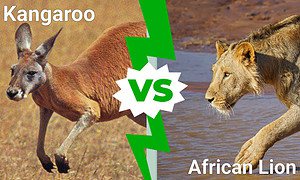Wallaby vs Kangaroo
Wallabies and kangaroos are two of the most recognizable marsupials. While both belong to the same family, they are very still very distinct, especially in terms of their height. But apart from the incredible difference in height, there is also a difference in their habitats, as both animals rarely ever intersect.
Their strength, weight, and teeth are distinct from each other, further adding to their list of differences. So if you’re looking to find out how these cute wallabies differ from the larger kangaroo counterparts, here is a rundown of all their major differences.
Comparing Wallabies vs Kangaroos
| Eastern Grey Kangaroo | Black Striped Wallaby | |
|---|---|---|
| Legs | Oversized and long | Compact and short |
| Size | 5.5 feet standing normally | Three feet standing |
| Teeth | No premolars | Premolars and Cutting Tooth |
| Color | Dull coat | Shiny coat |
| Weight | Between 50 and 66 kg | 11 kg |
| Lifespan | From 20 to 25 years | From 11 to 14 years |
| Habitat | Open woodlands and savannas | Forests with dense shrubbery |
| Species | Antilopine kangaroo (Australia, Cape York Peninsula) Western grey kangaroo (Australia, Western Victoria) | Red-necked wallabies (Australia, Tasmania) Tammar wallaby (Australia western and southern costs) |
| Body | Large bodies with powerful legs and tail | Short bodies with small feet ad short tail |
The 5 Key Differences Between Wallabies and Kangaroos
Wallabies and kangaroos come in a variety of species, each of which differs greatly in terms of their size and weight. Therefore, for the sake of simplicity, we are currently comparing the Eastern Grey Kangaroo and the Black Striped Wallaby. So in this section, we will be diving deeper into how these two marsupials differ from each other.
Wallaby vs Kangaroo: Size
Wallabies, in comparison, are much smaller than kangaroos coming in at almost half the average size. Most male wallabies can grow as large as three feet, while female wallabies only grow to two or two and a half feet. So even when they have become full adults, they are still the average size of a kangaroo joey.
Their smaller legs and general short stature allows them to hide in shrubbery away from their predators. The smaller legs also mean that they are able to better navigate the tighter spaces of forests. Their smaller size also means that they only weigh as much as 20 kg when fully grown.
The kangaroo is the largest marsupial in the world, with the tallest ones being as tall as eight feet when standing up straight. Different species of kangaroos can have different heights, along with different weights. The tallest recorded kangaroo has a height of over nine feet, being able to easily overshadow most humans, along with a weight of over 90 kg.
Kangaroos also have much larger feet. Using their massive feet, they are able to traverse large stretches of land at a comfortable speed of over 20 km/h. And when they start running fast, they can easily hit the 70 km/h mark. Their larger legs and claws also mean that they do not have any natural predators.
Wallaby vs Kangaroo: Color and Coat
The differences between these unique marsupials do not end at their height, as both mammals also have different coats. Wallabies can fall prey to many types of predators in the forest, which is why their coat is able to better camouflage them in their surroundings. They also have a more ornate fur, with two or three distinct colors throughout their coat.
Kangaroos, however, usually feature muted colors throughout their coat, with only a few breeds sporting as many as two colors. Furthermore, their coats will usually be grey or brown, with most of them having a yellowish, sand-ish color.
Wallaby vs Kangaroo: Longevity
Wallabies are not so fortunate, as they live roughly half as long as kangaroos at 11 or 14 years. Their predators include foxes and other, bigger feral cats.
Since kangaroos are such massive mammals, they do not have any natural predators. Most animals are intimidated by their height, and their powerful kick can easily push back most predators, which is why they tend to live longer. They can live as long as 20 or 25 years, with some even surviving to 30 years.
Wallaby vs Kangaroo: Molars and Teeth
Another difference between these mammals is their teeth and the shape they have. Wallabies have flat teeth, which they use to eat leaves in their natural habitat. Kangaroos usually live in plains, with their main food source being grass.
They have curved teeth that allow them to cut stalks of grass with ease. Compared to their smaller subspecies, kangaroos have less prominent crowns and do not have any premolars. Wallabies have premolars and cutting teeth that help them chew on leaves in the forest.
Wallaby vs Kangaroo: Habitat
Wallabies live in varied habitats, as they are dispersed into rocky mountains, woodlands, and even certain plains. Since so many different species live in unique climates, they carry unique characteristics. On the other hand, kangaroos live in a single habitat, with only a few species making it into the forest.
NEXT UP…
- Are Kangaroos Dangerous? Given their size, are kangaroos dangerous animals? Let’s find out.
- 10 Incredible Wallaby Facts. If you love wallabies as much as we do you will enjoy these fun facts.
- 10 Incredible Kangaroo Facts. Some of these facts are sure to surprise you!
The photo featured at the top of this post is ©
Thank you for reading! Have some feedback for us? Contact the AZ Animals editorial team.






